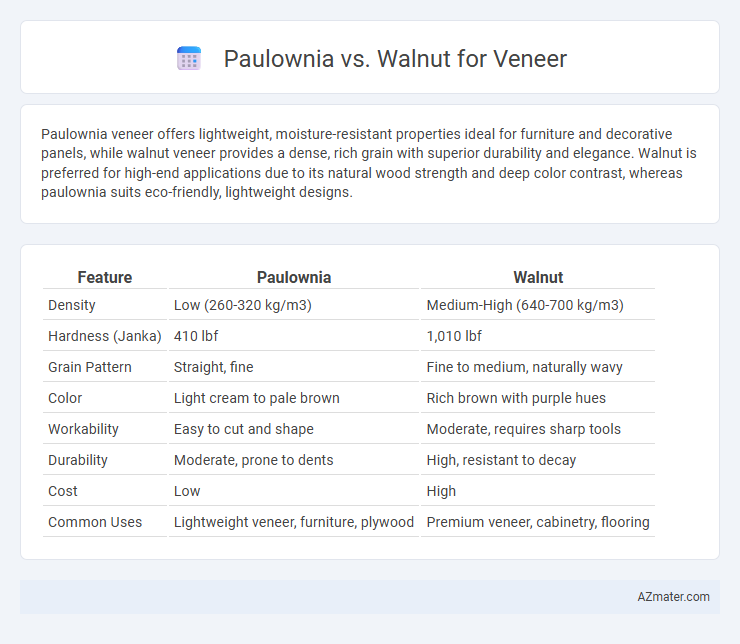Paulownia veneer offers lightweight, moisture-resistant properties ideal for furniture and decorative panels, while walnut veneer provides a dense, rich grain with superior durability and elegance. Walnut is preferred for high-end applications due to its natural wood strength and deep color contrast, whereas paulownia suits eco-friendly, lightweight designs.
Table of Comparison
| Feature | Paulownia | Walnut |
|---|---|---|
| Density | Low (260-320 kg/m3) | Medium-High (640-700 kg/m3) |
| Hardness (Janka) | 410 lbf | 1,010 lbf |
| Grain Pattern | Straight, fine | Fine to medium, naturally wavy |
| Color | Light cream to pale brown | Rich brown with purple hues |
| Workability | Easy to cut and shape | Moderate, requires sharp tools |
| Durability | Moderate, prone to dents | High, resistant to decay |
| Cost | Low | High |
| Common Uses | Lightweight veneer, furniture, plywood | Premium veneer, cabinetry, flooring |
Introduction: Paulownia vs Walnut Veneer
Paulownia veneer offers a lightweight, fast-growing alternative to traditional Walnut veneer, known for its rich grain and deep color. Walnut veneer provides exceptional durability and luxurious aesthetics, making it a popular choice for high-end furniture and cabinetry. Both veneers present unique textures and finishes, catering to different design preferences and functional needs.
Botanical Overview of Paulownia and Walnut
Paulownia, a fast-growing deciduous tree native to East Asia, belongs to the family Paulowniaceae and is prized for its lightweight, fine-grained wood, which makes it ideal for veneer applications. Walnut, primarily Juglans nigra (black walnut), native to North America, is a hardwood tree from the Juglandaceae family known for its rich, dark brown heartwood and strong, dense grain structure favored in high-quality veneer products. The botanical differences between Paulownia and Walnut influence their veneer qualities, with Paulownia offering rapid renewability and ease of machining, while Walnut provides superior durability and aesthetic value.
Growth Rate and Sustainability Comparison
Paulownia grows at an exceptionally rapid rate, reaching harvest maturity in just 7 to 10 years, which significantly outpaces walnut trees that typically require 30 to 40 years for optimal veneer-quality timber. The fast growth of Paulownia contributes to sustainable forestry by enabling quicker carbon sequestration and reducing land use pressure compared to slower-growing walnut species. Walnut veneer, prized for its rich grain and durability, requires longer cultivation periods and more intensive resource inputs, leading to a larger environmental footprint relative to the highly renewable Paulownia.
Appearance and Color Differences
Paulownia veneer exhibits a pale, creamy white to light brown color with a fine, straight grain, offering a smooth and uniform appearance suitable for modern and minimalist designs. Walnut veneer showcases rich, dark brown hues with deep chocolate and purple undertones, characterized by its pronounced, swirling grain patterns that add warmth and sophistication. The contrast in color intensity and grain complexity makes Paulownia ideal for light, airy interiors, while Walnut enhances spaces requiring luxurious, classic aesthetics.
Grain Patterns and Texture
Paulownia veneer features a fine, straight grain pattern with a smooth, lightweight texture, making it ideal for applications requiring a subtle, uniform appearance. Walnut veneer displays a rich, complex grain with swirling and straight lines, offering a dense texture that adds warmth and visual depth to furniture surfaces. The choice between Paulownia and Walnut veneers depends on the desired aesthetic and tactile experience, with Paulownia leaning towards minimalism and Walnut emphasizing natural elegance.
Durability and Hardness
Paulownia veneer is lightweight with a Janka hardness rating around 350, making it less durable and prone to dents compared to walnut, which has a higher Janka hardness of approximately 1010, providing superior resistance to wear and impact. Walnut veneer offers enhanced durability due to its dense grain structure, ideal for high-traffic furniture and cabinetry surfaces. Choosing walnut ensures longevity and scratch resistance, while paulownia suits applications where weight reduction is prioritized over hardness.
Workability and Machining
Paulownia veneer is lightweight with a fine, even grain, making it highly workable and easy to cut, sand, and shape, ideal for intricate detailing and delicate applications. Walnut veneer, known for its hardness and dense grain, requires sharper tools and slower machining speeds but offers excellent durability and a smooth finish, suitable for high-end furniture and cabinetry. Both materials respond well to adhesives and finishes, yet Paulownia excels in ease of handling while walnut demands more precision due to its toughness.
Cost and Availability
Paulownia veneers offer a significant cost advantage over walnut veneers, with prices typically 30-50% lower due to the faster growth rate and abundant supply of paulownia trees. Walnut veneers, prized for their rich color and grain patterns, tend to be more expensive and less readily available because walnut trees mature slowly and are less abundant. For projects requiring budget efficiency and quicker turnaround, paulownia provides a more accessible option, while walnut remains preferred for premium quality and traditional aesthetics.
Best Applications and Uses
Paulownia veneer is prized for its lightweight, stability, and resistance to warping, making it ideal for decorative paneling, furniture backing, and lightweight cabinetry where durability is less critical. Walnut veneer offers a rich, dark grain pattern with superior hardness and wear resistance, perfectly suited for high-end furniture, cabinetry, and luxury interior finishes requiring both aesthetic appeal and durability. Both veneers serve distinct applications, with paulownia enhancing lightweight design projects while walnut excels in premium, long-lasting wood surfaces.
Environmental Impact and Eco-Friendliness
Paulownia veneer offers a highly sustainable option due to its rapid growth rate, requiring fewer resources and less time to mature compared to walnut trees, which take decades to reach harvest size. Walnut veneer, while prized for its rich color and durability, has a larger environmental footprint because of slower growth and often involves more intensive forestry practices. Choosing paulownia supports eco-friendly furniture production by reducing deforestation pressure and carbon emissions associated with long-growth hardwoods like walnut.

Infographic: Paulownia vs Walnut for Veneer
 azmater.com
azmater.com